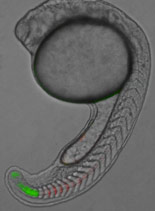Small World In Motion Honorable Mention Winner Highlight: Dr. Daniele Soroldoni

Posted on January 05, 2015
For any vertebrate animal, “segmentation,” or the biological division of an animal into repetitive segments such as ribs and vertebrae, is essential to ensure proper physique. Despite its necessity to the vertebrae body plan, segmentation is all too often overlooked for more glamorous processes. Dr. Daniele Soroldoni, this month’s Nikon Small World in Motion highlight, promotes an appreciation for this phenomenon by bringing it into focus beneath the microscope.
Segmentation is notoriously difficult to visualize due to its occurrence during embryo development, so Dr. Soroldoni sought to visualize the patterning sequence at the molecular level. His resulting video beautifully illustrates the pattern formation during segmentation, to show both when and where each vertebrae segment is formed. The clip actually expresses the point in time (denoted by the green wave) in which temporal information is translated into spatial information. Where the green wave stops, the red gene appears in the position where the next segment boundary is formed, ultimately displaying the vertebrates’ growth processes.
Dr. Soroldoni accomplished this capture in his research lab at University College London by delicately embedding fluorescent protein into the chromosome of a zebrafish to create a fusion among the genes of interest. He then tagged the genes in red and green to enable tracking. Using multi-dimensional wide-field microscopy, he combined a large field of view with a highly sensitive and fast EM-CCD camera which enabled him to detect and follow the very faint and transient activity of multiple BAC* transgenes simultaneously.
Ultimately Dr. Soroldoni’s video not only shows a beautiful glimpse into a rarely noticed biological process – but highlights the toolbox he developed for the scientific community, opening the door for continued knowledge and understanding of a complex genetic network.
* A bacterial artificial chromosome (BAC) is an engineered DNA molecule used to clone DNA sequences in bacterial cells.
